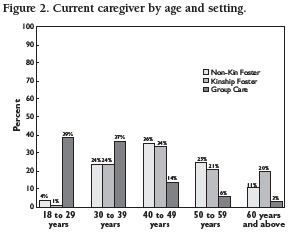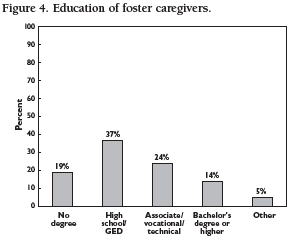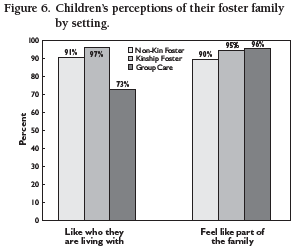Return to Previous page |
| PDF Version, Color |
National Survey of Child and Adolescent Well-Being
Administration for Children and Families
Office of Planning, Research and Evaluation
No. 2: Foster Children’s Caregivers and Caregiving Environments
Research Brief
Findings from the NSCAW Study
According to most recent estimates, over 530,000 children are in foster care in the United States. These children live in a variety of settings, including non-relative foster homes, the homes of relatives, and group homes. However, despite widespread concern for these children, little research has been available to provide a national picture of the circumstances in which these children reside. NSCAW presents a unique profile of the experiences of children in foster care in the United States. Focusing on a national sample of children in foster care for 1 year, it provides a portrait of foster caregivers and foster caregiving environments, as well as the perceptions that children themselves have about their foster caregivers and their experiences in foster care.
This research brief answers the following questions:
-
Who is caring for the children in foster care?
-
What are the environments in which foster children are being cared for?
-
What are children’s perceptions of their foster caregivers and caregiving arrangements?
-
What are the plans for reunification of this population?
These questions are answered using information for the population of children in foster care in this study’s sample. In addition, differences across types of caregiving settings (non-kin foster homes, kinship foster homes, and group homes) are highlighted.
Research Methodology
The National Survey of Child and Adolescent Well-Being (NSCAW) is a national longitudinal study of the well-being of more than 6,200 children who had contact with the child welfare system within a 15-month period starting in October 1999. These children—ages 14 and younger—were selected from two groups: 5,501 from among those entering the child protective system in that period, and 727 from among children who had been in out-of-home placement for about 12 months at the time of the study. Out-of-home placement includes conventional foster care, kinship foster care, group care, residential treatment, and other settings. Throughout this brief we refer generally to these out-of-home placements as foster care.
This research brief focuses on the 727 children who had been in foster care for 12 months at the time the study began and their current caregivers. The data were drawn from interviews with the children, their current caregivers, and their caseworkers a few months after the study began in 1999. The average age of the children in this sample was 7 years. Over 50% of the children were in traditional, non-kinship foster homes, 33% were in kinship foster homes, and an additional 15% were in group homes. (More details on the children are available from Research Brief 1 in this series.) It is important to note that only a small number of children from group care were sampled, so findings related to this particular group should be interpreted with caution.
Characteristics of Caregivers
What are the basic demographic characteristics of those who are caring for America’s foster children? Data on age, race, education, marital and employment status, and prior foster parenting experience can help identify foster parent recruiting needs by indicating which populations are less represented and which are overrepresented among the foster parent population.
Age
In this sample of children in foster care for 1 year, 62% of caregivers were 40 years of age or older (see Figure 1).

[D] |
The age of the caregivers differed by the type of setting in which the child was being cared for (see Figure 2). Non-kin caregivers were four times as likely as kin caregivers to be between 18 and 29 years of age, and also more likely to be between 50 and 59 years of age. Kin caregivers were twice as likely to be 60 years or older as non-kin caregivers. These differences may reflect the fact that more than one-half of kin caregivers were the grandmothers or great-grandmothers of the foster child. Caregivers in group settings were quite a bit younger; more than 75% were under the age of 40.

[D] |
Race
Foster caregivers have diverse cultural and racial backgrounds (see Figure 3). In most cases, the race or ethnicity of the caregiver matched that of the child, and there were few differences in the racial and ethnic breakdown of kin and non-kin caregivers. However, children from “other” racial or ethnic backgrounds were about as likely to be living with an African American, non-Hispanic caregiver, a white, non-Hispanic caregiver, or a Hispanic caregiver as a caregiver from another racial or ethnic group.

[D] |
Marital status, education, employment, and income
There were few differences in the marital or employment status or education history of caregivers in the different caregiving settings. Foster caregivers were almost as likely to be single as married; kin caregivers and non-kin caregivers did not differ significantly in this respect.
The majority of caregivers reported that they had a high school education or less (see Figure 4). There were no significant differences between kin and non-kin caregivers in education.
Forty-one percent of caregivers worked full-time, and 36% did not work. Employment did not differ significantly for kin and non-kin caregivers. There were no significant differences in income between kin and non-kin caregivers; however, there was a tendency for kin caregivers to be more represented than non-kin caregivers among those with income lower than $25,000 per year and less represented among those with income over $50,000 a year.

[D] |
Although few differences were found between kin and non-kin caregivers, group caregivers differed from the others. As mentioned earlier, caregivers in group care were younger than other caregivers. They were also more educated, with nearly two-thirds of these caregivers holding a bachelor’s degree.
Foster parenting experience
The amount of foster parenting experience of caregivers varied widely and was significantly different based on whether the caregiver was related to the child. Forty-nine percent of all foster parents—kin and non-kin—had less than 3 years of experience as a foster parent, while about a third had over 5 years of experience. Another quarter had 3 to 5 years of experience. Kin and non-kin caregivers differed significantly in their experience, with kin caregivers reporting less experience than non-kin caregivers (see Figure 5). More than half of kin caregivers had no more than 1 year of experience, whereas more than a third of non-kin caregivers had at least 6 years of experience.

[D] |
Characteristics of the Caregiving Environments
A second question pertains to the characteristics of foster children’s caregiving environments. The NSCAW is unique in being able to provide national data on the household size of foster homes and the quality of the home and neighborhood in which foster children are living.
Number of household members
The average number of members in the homes of kin and non-kin foster caregivers was 5.2, with an average of 2.1 adults and 3.1 children. Non-kin caregivers had larger households than kin caregivers, having an average of one more child. In fact, approximately one-third of non-kin homes had five or more children present.
The relationships between the foster children and other children in the household also differed according to the caregiving setting. Children in kin caregivers’ homes were most likely to be biological, step, or adoptive siblings of the foster child, whereas in non-kin homes they were most likely to be foster siblings.
Quality of the neighborhood
The caregivers themselves reported on characteristics of the neighborhood in which the caregiver (and foster child) resided. These reports described the presence of assaults and muggings, gangs, unsupervised children, cooperation among neighbors, parental involvement, and safety, among other factors. Overall, caregivers reported their neighborhoods as having few problems and being above average compared to other neighborhoods.
There were few differences between non-kin foster homes, kinship foster homes, and group care in the quality of the neighborhood reported. Kinship foster homes had no more threats—such as gangs or open drug use or dealing—than group homes or non-kin foster homes. However, kinship foster homes had fewer neighborhood strengths than non-kin foster homes.
Children’s Perceptions of Their Caregiving Arrangements
One of the most unusual attributes of the NSCAW study is its ability to provide a portrait of how children in foster care for 1 year feel about their caregiving situations. This information includes children’s overall level of satisfaction with their arrangements as well as areas that the children themselves would like to see improved.
Relationships with their current caregivers
Children ages 11 and older reported on their relationships with their caregivers, including such things as the caregiver’s degree of involvement, supportiveness of the child’s autonomy, and emotional security. The children reported on their relationships with both their primary and secondary caregivers in their foster home.
On average, children felt positive about both their primary and secondary caregivers. This was true in both kinship and non-kin caregiving environments, though children in group care reported less relatedness to their caregivers than children in kinship care.
Children felt close to their primary and secondary caregivers and felt that their caregivers cared about them. Yet, these children felt less close to their caregivers than did children in a nationally representative sample of all 7th through 12th graders comprising mostly children without contact with a child welfare agency.
The vast majority of the children reported liking the people they live with and feeling like a part of their foster family (see Figure 6). More than a third of the children reported wanting to be adopted by their foster family, and one-half indicated they want their current home to be their permanent home. Just 11% of the children had tried to leave their current placement.

[D] |
Children’s views of their biological families
Children ages 6 and older were asked where they would like to live in the future and their views on their biological parents.
Overall, the children reported wanting more contact with their biological parents. More than half (61%) reported seeing their biological mother no more than twice a month, and nearly two-thirds reported wanting more contact with their mothers. Over 70% of the children reported that they see their biological fathers no more than twice a month, and 60% desired more contact with their fathers. More than three-quarters of the children wanted more contact with their siblings and reported frequently missing their family.
Most of the children described their family visits as pleasant experiences, though cancellations were reported as frequent. Approximately one-third of the children reported that visits with their families were frequently cancelled. Nearly three-quarters of the children reported feeling happy after family visits, while only a quarter of children reported feeling sad after family visits. Relatively small percentages of children reported feeling angry, worried, lonely, afraid, or guilty afterward. Only 12% of the children reported avoiding family visits.
Nearly 60% of the children indicated that they believe they will live with their biological parents again, and three-quarters believe that the experience will be different than in the past. When asked with whom they would want to live, children most often nominated their biological mothers and fathers (see Figure 7).

[D] |
Differences in children’s perceptions by caregiving setting
Children in group homes were far less satisfied with their current placements than children in kinship and non-kin foster homes. Children in group homes were far less likely than children in the other two settings to like those with whom they were living and were less likely to want their current placement as a permanent home. Among children 11 or older, those in group homes were more likely than those in kinship care to have tried to run away. Children in group care were also four times as likely to have family visits cancelled as were children in kin and non-kin foster homes.
Overall, children in kinship care appeared somewhat happier with their placements than children in other types of care, particularly those in group care. Children in kinship care reported seeing their family members more than those in non-kin or group care and were far less likely to frequently miss their family. Still, most children reported positive views of their caregiving environments, while still hoping to be reunified with their families.
Plans for Family Reunification
Given the experiences children are having in their current caregiving environments, what plans exist for reunifying them with their families?
Among the 75% of the children who had not yet been reunified, about a quarter had an existing reunification plan, primarily with a biological parent. Prior efforts at reunification had been made for 84% of those who did not have a current reunification plan. In fact, only 8% of the children in the study had never had a reunification plan.
The existence of reunification plans did not differ substantially by the age or race of the child. Children who had experienced failure to supervise as their most serious form of maltreatment were most likely to have been reunified or have a reunification plan. Among those who had not yet been reunified, children in group care were most likely to have a reunification plan.
Summary
This brief provides a portrait of those taking care of foster children in our country, the environments in which these children are being cared for, and the children’s perceptions about their caregiving arrangements. The NSCAW data reveal some favorable findings, such as the positive feelings that children express toward their foster parents and families, particularly those children in kinship care. Moreover, few differences are found between kinship care and non-kin foster homes, which may alleviate some concerns about the growing use of kinship care options.
However, these findings also highlight some issues for future consideration, such as the frequency of children’s family visits, the large household size in non-kin foster homes, the relatively low educational and economic status of both kin and non-kin caregivers, and the less positive perceptions of caregiving environments expressed by children in group care. The longitudinal follow-ups from NSCAW will allow the examination of some of these issues in terms of their contributions to the children’s well-being over time.
National Survey of Child and Adolescent Well-Being Research BriefAvailable at: Administration for Children and Families (ACF, OPRE) http://www.acf.hhs.gov/programs/opre/abuse_neglect/nscaw/ A copy of the National Survey of Child and Adolescent Well-Being: Baseline Report for One Year in Foster Care Sample, which discusses these findings in more detail, can be obtained from the Administration for Children and Families at the web address above. The report was prepared for the Administration for Children and Families (ACF, DHHS) by the NSCAW Research Group, a collaborative effort of Research Triangle Institute (RTI), the University of North Carolina at Chapel Hill (UNC), Caliber Associates, the University of California at Berkeley (UCB), and the ACF. This is the second in a series of NSCAW research briefs, developed by Caliber Associates from the Baseline Report, focused on children in foster care who come into contact with the Child Protective System. Additional research briefs focus on the characteristics of children in foster care, the provision of services to children and their families, and changes in child well-being over time. |
| Return to Previous page |



